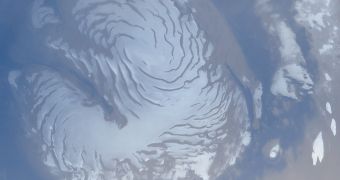New measurements of Mars' south polar region indicate extensive frozen water, but could it be more to it than we presently now?
Actually, the polar region contains enough frozen water to cover the whole planet in a liquid layer of approximately 11 meters (36 feet) deep.
These south polar layers cover an area bigger than the state of Texas, but the amount of water they contain, though estimated before, is only now being more accurately calculated from mapping the thickness of the ice.
A joint NASA-Italian Space Agency instrument on the European Space Agency's Mars Express spacecraft provided these data.
The instrument, named the Mars Advanced Radar for Subsurface and Ionospheric Sounding (MARSIS) is mapping the thickness of the polar layers by measuring and analyzing the echo that the radar receives from those layers.
"Not only is MARSIS providing us with the first ever views of Mars subsurface at those depths, but the details we are seeing are truly amazing.
We expect even greater results when we have concluded an ongoing, sophisticated fine-tuning of our data processing methods.
These should enable us to understand even better the surface and subsurface composition," said Giovanni Picardi, a professor at the University of Rome "La Sapienza" and principal investigator for the instrument.
The Mars Express orbiter's radar instrument has made more than 300 virtual slices through icy layers to the lower boundary, which can be as deep as 3.7 kilometers (2.3 miles) below the surface.
The layers extend beneath a polar cap of bright-white frozen carbon dioxide and water at Mars' South Pole.
Dust darkens many of the layers, but the strength of the echo that the radar receives form the rocky surface underneath suggests the composition of the layered deposits to be of at least 90% frozen water.
However, one area with especially bright reflection from the base of the deposits puzzles researchers. It resembles what a thin layer of liquid water might look like to the radar instrument.
Could there be a liquid layer of water on Mars ?
Most scientists don't consider this a plausible explanation, due to the extremely cold conditions on the planet; although they admit that other areas of the planet appear to have been very wet at times in the past.
Understanding the history and fate of water on Mars is a key to studying whether the planet has ever supported life or could it still do so, since all known life depends on liquid water.

 14 DAY TRIAL //
14 DAY TRIAL //